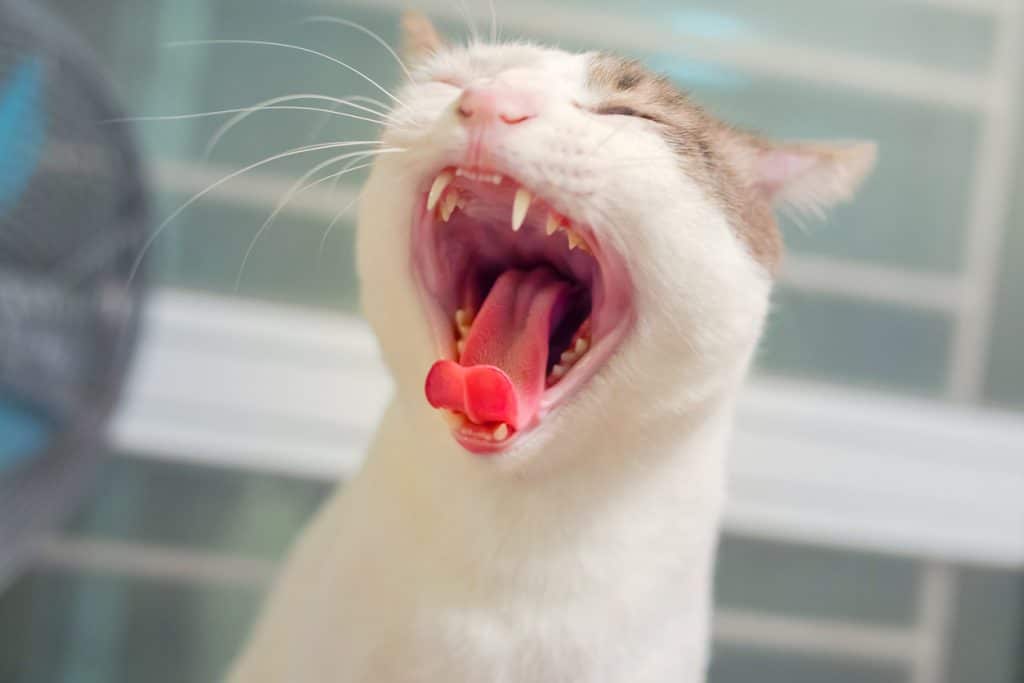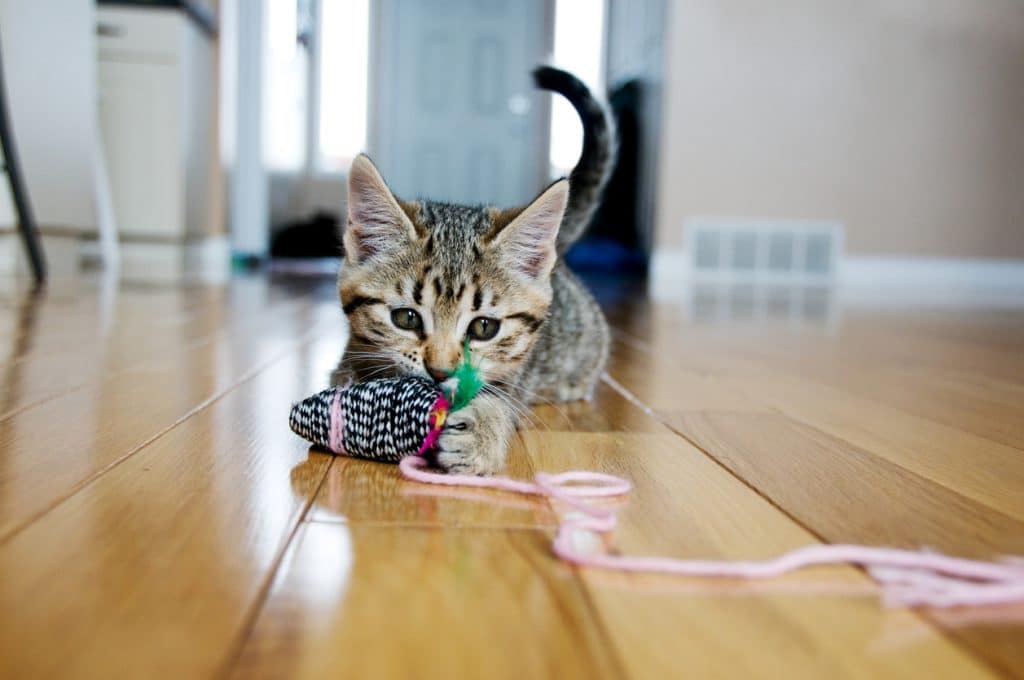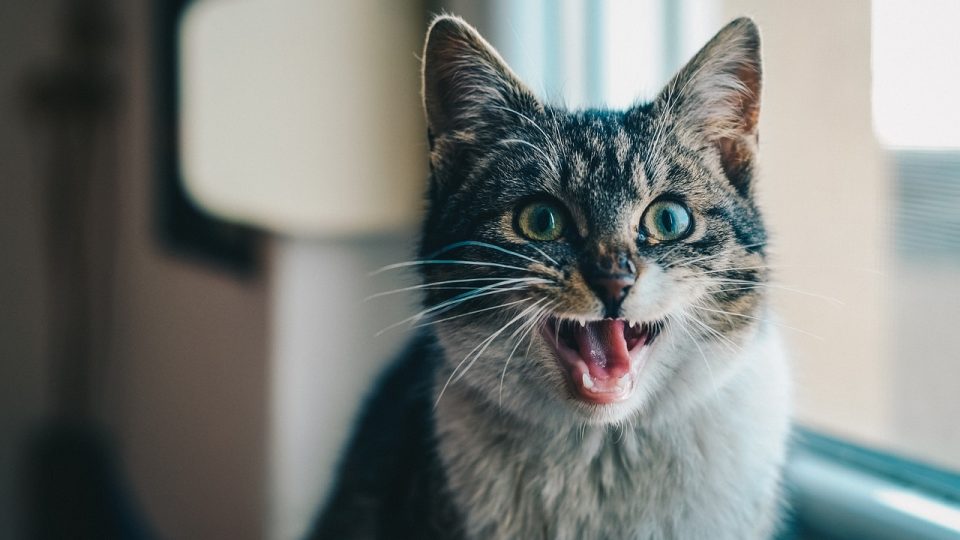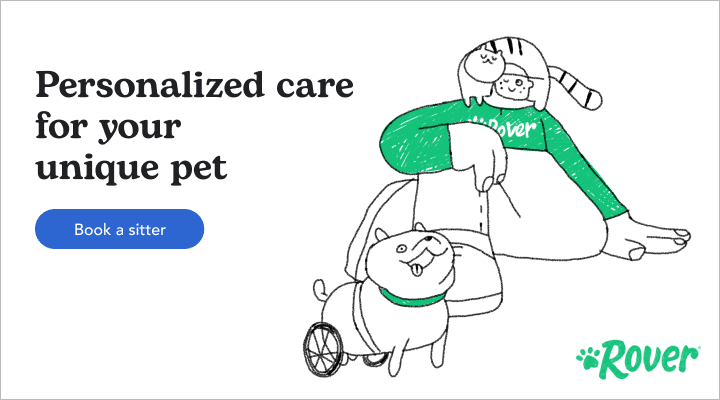- Not a substitute for professional veterinary help.
Like human babies, kittens are born without any teeth protruding through their gums (mother cat probably appreciates that). Kitten teeth don’t start erupting until they’re around 3 weeks old. And, just like human babies, they don’t pop out all at once.
Kitten baby teeth—otherwise known as deciduous teeth, primary teeth, or milk teeth—will arrive, and fall out, at different stages of your kitten’s development.
Cat baby teeth push through the gums over several weeks, usually with all of them present by 6 to 8 weeks. This is right around the time that kittens are fully weaned. And 8 weeks is about the youngest you’ll be able to adopt a kitten from any shelter. It’s a good idea to start getting them used to having their teeth brushed as soon as possible, so they can have a healthy mouth for years to come.
Kitten Baby Teeth Development & Fall Out
There are three types of kitten teeth (incisors, canines, and premolars), and they each arrive at different stages. The only teeth that won’t appear until adulthood (at around 20-24 weeks) are your cat’s molars.
To sort out this timeline, we spoke with Dr. David Littlejohn, DVM, a veterinarian and consultant at Pawsessories.
| Type of Kitten Baby Teeth | Age of Development | Age of Falling Out |
| Incisors | 2 weeks | 11-16 weeks |
| Canines | 4 weeks | 12-20 weeks |
| Premolars | 6 weeks | 16-20 weeks |
How Many Teeth Do Cats Have?
Adult cats have 30 permanent teeth, and each type of tooth has its own special function.
| Type of Adult Cat Teeth & Function | # of Teeth (Upper: Lower) | Age of Development |
| Incisors (Grasping) | 6:6 | 3.5-4.5 months old |
| Canines (Tearing) | 2:2 | 5 months old |
| Premolars (Grinding) | 6:4 | 4.5-6 months old |
| Molars (Grinding) | 2:2 | 4-5 months old |
- Incisors: These are the tiny front teeth between your cat’s pointy canines. They’re useful for nibbling, holding food, and grooming.
- Canines: Also known as eye teeth or fangs, canines will be the fourth tooth from the center on both sides. These sharp teeth help your cat grasp and tear food.
- Premolars: Premolars appear directly behind the canines. These teeth grind food for easier swallowing.
- Molars: Only seen in adult cats, molars erupt behind a cat’s premolars. Like premolars, they’re designed for grinding.

iStock/bombermoon
When Do Cats Lose Their Baby Teeth?
Yes, your cat’s baby teeth will fall out—and quite quickly. Typically, they’ll start to lose their incisor teeth around 11 weeks, Dr. Littlejohn tells us, and they’ll have their adult teeth by six months.
During this time, you may find baby cat baby teeth in their bedding or elsewhere around the house. If you don’t spot any teeth on the ground, but do see that their teeth have begun being replaced, it’s possible your cat swallowed some by accident—totally normal and no cause for alarm.
Signs Your Kitten Is Losing Their Baby Teeth
When your kitten’s baby teeth are ready to push through the gums, it can be an uncomfortable time for your pet. You may notice some bleeding when your kitten is teething, but Dr. Littlejohn assures us this is normal and not something to worry about.
Pain-wise, your cat is more likely to experience discomfort once their adult teeth start poking through. Dr. Littlejohn explains: “The final push by the adult teeth causes slight inflammation and a small wound, which causes bleeding to occur. This is a considerably uncomfortable period, as their adult teeth push through the gums and establish themselves.”
In addition to bleeding, Dr. Littlejohn lays out the following signs that your kitten is teething:
- Slow chewing
- Eating less
- Chewing excessively, especially on toys, bedding, and furniture
- Drooling
- Pawing at their face
- Red gums
- Teething kittens may also become cranky
What Can I Do To Help My Teething Kitten?
It’s no fun to see your precious cat be uncomfortable. There are a few things you can do to make the teething process a little less miserable.
- Give your cat plenty of soft chew toys to nibble on: Not only will it help them feel better, but it may also help direct their attention away from less desirable chewing spots like your couch or rugs, or bedding. You know. The areas you were hoping your cat wouldn’t decide to destroy. Also an option: kitten binkies. Yes, really. KittyBest has a tutorial on how to make one.
- Get dangerous items out of the way: As much as toys may be helpful, your kitten is likely to still find their way to unsavory spots, like wires or toxic plants. Do a careful sweep of the house and put any chewable items in a room where your cat can’t get to them.
- Switch to (or continue with) soft food: Dr. Littlejohn offers this advice: “If you notice your kitten is in quite a bit of discomfort, you can switch to wet food until their adult teeth have fully grown in.”
It’s also a good time to reinforce good behaviors. Don’t let a kitten bite your hands, even in a playful way. Every time they do, yelp “ow,” so you don’t accidentally let them think that roughhousing is acceptable.

iStock/Wildroze
Persistent Tooth: What to Do If Your Cat’s Teeth Won’t Fall Out
In an ideal scenario, your cat will lose all their baby teeth and have them replaced with adult teeth (including four additional teeth), bringing their total teeth up to 30. But sometimes cats can develop what’s called a “persistent tooth,” or retained deciduous teeth.
A persistent tooth happens when the root of the baby tooth isn’t reabsorbed into your cat’s body, leading the baby tooth to stay in place and blocking the way for the adult tooth to come through. It’s most common in upper and lower canine teeth.
The result is that the adult tooth has to find another way through, and ends up growing at an angle—the adult tooth and baby tooth occupying the same socket. This can crowd your cat’s mouth and lead to them having an abnormal bite. Food can get stuck and cause increased tartar and decay, as well as gum issues like gingivitis.
In these cases, it’s best to have the baby tooth extracted by a veterinarian as early as possible. Otherwise, you could be looking at bigger problems down the road.
The Takeaway:
While losing teeth is an ordinary part of kitten development, it’s not normal for adult cats to lose them. If your adult cat has lost a tooth (or multiple teeth), he should be taken to the vet. During your visit, you can ask for pointers on how to brush your cat’s teeth (it’s not as dreadful as you might think!) And it’s 100% worth it. Proper dental care is critical to your cat’s overall health. It’s also essential for preventing dental disease, which can have a major impact on a pet’s quality of life.


